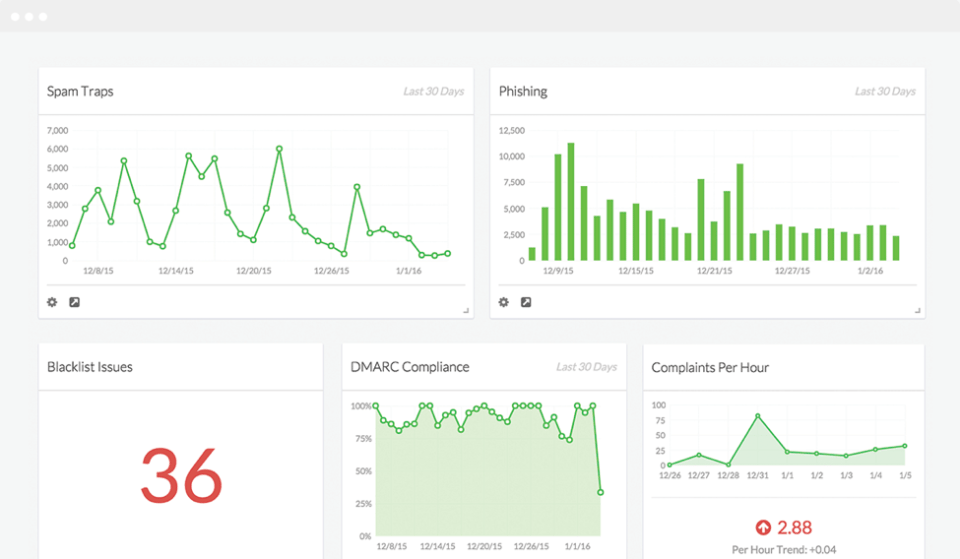Send With Confidence
Partner with the email service trusted by developers and marketers for time-savings, scalability, and delivery expertise.


Time to read: 7 minutes
At Twilio SendGrid, we always stress the importance of a strong email reputation, otherwise known as your sending reputation. Subscriber reactions to your emails drives this measure of how mailbox providers judge your reputation.
So if your email outreach attempts generate a surplus of spam complaints, it impacts your sending reputation, making it difficult for future messages to reach subscriber inboxes.
Read on to learn about key tools, statistics, and tips you can use to monitor and understand your sending reputation better.
If you’re used to sending a lot of emails without a second thought, you might wonder: “Why is sending reputation important?”
Simply put, the quality of a sender’s email reputation establishes whether a user’s mailbox provider will direct all sent emails to user inboxes or whether their email will get sent to spam folders instead. Conversely, when recipients engage with your emails, your sending reputation improves—so future messages are more likely to reach the inbox.
According to the Data & Marketing Association’s 2020 Consumer Email Tracker Report, only 58% of users check the spam folder of their personal inbox daily, as opposed to a much greater 95% of users who check their general inbox daily. In other words, for organizations looking to maximize email outreach efforts, sending reputation is everything.
While there’s no singular sender score that all mailbox providers use to evaluate your email reputation, there are third-party and mailbox-specific tools that can help you understand how mailbox providers might sort your messages.
These tools leverage different data sources—as well as sending practices and user opening performance—to score the organization’s sending reputation.
As singular sources of truth, these scores often fail to tell the whole story. But when used in conjunction with other data points, these can be vital ways to pinpoint any email reputation challenges impeding your organization. Some tools that walk you through how to check your domain reputation include:
Validity’s Sender Score is a free email reputation measurement, similar to how a credit score reflects your credit history. As your Sender Score increases on the scale from 0 to 100, your sending reputation improves—which benefits your email deliverability rate. This data is calculated on a rolling 30-day average and illustrates where your IP address ranks among others.
Barracuda Networks provides both IP and domain reputation lookups via its Barracuda Reputation System—a real-time database of IP addresses containing “poor” or “good” ratings. By using this service, you can check your domain’s IP score to see whether your emails pass as legitimate or spam.
McAfee provides a service for looking up information on your domain’s email and web reputations within various versions of the SmartFilter network or WebWasher URL Filter Database. Depending on the product you choose, you can also search for data on the domain history, associations, the domain name system, and mail server.
Google offers Postmaster Tools to help senders track data on high-volume email batches sent to user Gmail accounts. This information gives your organization insights on your IP and domain reputation, feedback loops, and specific delivery errors.
Microsoft offers a service similar to Google’s Postmaster Tools called Smart Network Data Services (SDNS). SNDS provides insights into data points like your spam complaint rate, your IP sending reputation, and the number of deliveries to Microsoft spam traps—email addresses that identify senders that don’t follow email best practices.
With these tools, you can easily get a useful daily evaluation of your message reputation as viewed by major providers, which can be crucial. After all, it’s safe to say that red flags thrown by the largest providers in the world get shared with many other providers.

When combined, these data points can be a great way to evaluate your sending reputation. But that can make it easy to fall into the trap of trusting one piece of information alone.
For example, it’s not uncommon to see email senders with Sender Scores around 98–99 encounter issues with proper inboxing. And just because you have a high reputation score from a third party doesn’t mean you don’t risk throttling, landing in the spam folder, or getting blocked outright.
By blending the scores you receive from the tools above with the insights and tips recommended below, you’ll be able to more deeply understand your sending reputation with today’s top mailbox providers.
Consider how your statistics trend to shape your overall reputation going forward. Since sending reputation revolves around how many of your emails make it to user inboxes, active trends, such as decreasing open rates or increasing spam complaint rates, tend to be the most reliable indicators of existing or pending reputation degradation.
Conversely, improvements in your deliveries or open rates over time can indicate improvements to your sending reputation over time. And since each mailbox provider has its own way of operating, it can be even more helpful to watch for these changes on a domain-by-domain basis to best identify reputation issues unique to specific providers.
When emails generate too many negative signals due to issues like spam complaints or deliveries to watchdog technologies like spam traps and honeypot addresses, you’ll likely see increased deny listings of your IP, domain, or both.
While not all deny lists will significantly impact your delivery rates, increases in denylisting events can indicate your sending reputation is suffering. Try a free tool to watch for denylistings.
If you have multiple email addresses at different mailbox providers, try sending to all of them. While it’s never safe to assume how a mailbox provider treats all your mail based on results returned to a single address, observing changes in how your emails land in your inboxes or spam folders can be a good indication. It could tell you if your reputation may be degrading, especially when combined with other data points.
And if your messages consistently land in your spam folder, try an email deliverability test by positively engaging with them by returning them to your inbox.
While these tools can help you check IP, sending, and domain reputation, spam score, and more, senders typically only use them reactively. Once they notice a problem, then they become concerned about their reputation authority.
Regardless of your scores, be proactive about protecting your reputation. Follow email best practices to keep yourself on good terms with all the major inbox providers.
SendGrid provides excellent tools to help you do just that—and take control of your sender reputation:
SendGrid’s email testing tool helps you send emails with confidence by catching errors before you send.
The real-time email address validation API from SendGrid makes your emails more deliverable by validating email addresses before you send. This tool helps you more effectively monitor your email list to ensure mistyped, inactive, nonexistent, and disposable emails stay off your contact list.
With a cleaner email list, you can reduce your bounce rates and improve your sending reputation with mailbox providers—all to drastically increase your delivery rates.
Deliverability insights provides you with a single dashboard to monitor and improve your entire email program. With deliverability insights’ actionable and easy-to-digest format, you’re better equipped to understand your email performance at a glance—no more wasting time digging through menus and tabs to find the data needed.
Your email reputation should always be in your control. With the right tools, tactics, and data points, you can gain more accurate visibility into how mailbox providers treat your sent mail at the point of receipt.
Ready to proactively manage how your emails are delivered and received? Partner with Twilio SendGrid. Our Expert Services offer over 130 years of combined email industry experience to ensure your email program is ready for success.Use these Twilio SendGrid tools, stats, and tips to improve email deliverability, learn how to check your domain reputation, and set email marketing programs up for success.
Partner with the email service trusted by developers and marketers for time-savings, scalability, and delivery expertise.